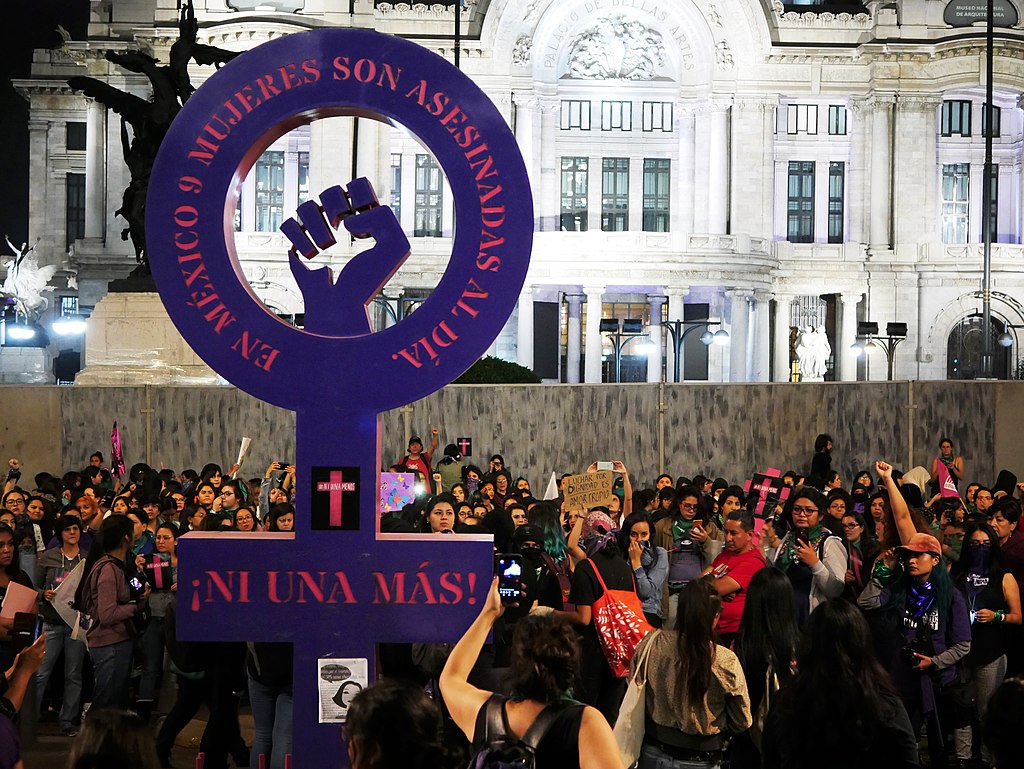 Image courtesy of "Feminism in Latin America", Wikipedia
Image courtesy of "Feminism in Latin America", Wikipedia
Women’s Rights and National Security: A View From Latin America
Recent female-led protests in Mexico, Argentina, and Chile reveal the challenges to women’s rights in the region and the dearth of funded, enforceable policies to address them. By meeting protesters’ demands, Latin American governments and U.S. diplomats can help shape educated and economically independent women who contribute to Latin American and U.S. national security.
Sources and Expressions of Discontent
In late fall of 2019, footage of Chilean street protests went viral on social media. A choreographed chant performed at many of them, “Un violador en tu camino” (“A Rapist in your Path”), struck a chord with women across Latin America and beyond. The Chilean women protesting highlighted demands for equal and livable wages, healthcare and legal abortion, streamlined justice for gender violence, and international recognition of the systemic nature of the problem. Similarly, protests in Mexico have continued since August of 2019. At the time, women marched and defaced monuments to highlight the high rates of femicide and harassment, as well as the low rates of punishment for sex offenders. This past March, Mexican women staged a national boycott of work and school to draw attention to violence against women. In Argentina, there have been yearly marches since 2015 in support of legal abortion and LGBT rights, as well as against high rates of femicide. Under COVID-19 lockdown, Argentina has also seen a sharp rise in domestic violence statistics, which has propelled small groups of women to protest in the streets.
Women’s protests are driven by short-term and long-term factors. As illustrated in Argentina, COVID-19 has exacerbated existing economic and social inequalities between men and women. After schools closed, some women had to sacrifice their jobs for childcare and subsequently lost economic independence, while possibly trapped at home with a domestic abuser. Beyond COVID-19, both right-leaning and left-leaning political leaders fueled discontent by downplaying the importance of women’s rights. While signing legislation combatting violence against women, Chile’s president disparaged women for “allowing abuse to happen”. When faced with female-led protests, Mexico’s president claimed it was the work of his political rivals, while the First Lady exhorted women on social media to return to work on the day of the proposed boycott.
Women’s Rights and National Security
Though seemingly an issue for regional politics, women’s rights in Latin America have a direct impact on U.S. national security. U.S. national security is fortified when foreign countries have the commitment and resources to address women’s needs. Research demonstrates that women with protection from physical violence and with access to education help reduce their countries’ political violence and contribute to more durable post-conflict peace negotiations. In fact, women’s rights are so central to U.S. national security that the State Department enshrined their protection into an Obama-era program called the Equal Futures Partnership. Statistics from the U.N. illustrate that “when more income is put into the hands of women, child nutrition, health and education improve”, which directly supports the wage-gap demands by Argentine, Chilean, and Mexican women. As educated and physically protected women’s demands become reflected in new policies, these women will increase their countries’ political, economic, and social development. In turn, this may reduce their country’s reliance on U.S. economic or military assistance and create more durable cross-hemispheric partnerships.
Formulating Policy for Women’s Demands
Any response to women’s protests should include both domestic policy changes and international collaboration to share resources. Between Mexico, Chile, and Argentina, Argentina’s president has most intensively integrated women into his cabinet, federal ministries, and official policy agendas. As women’s rights campaigns persist, Mexico and Chile may follow suit. These countries are incentivized to enact policy because delay or dismissal of the issues risks incurring further protests that are visibly covered by international media. This in turn adds more pressure to produce policy solutions. Latin American countries can also deepen intra-regional collaboration to help convert protesters’ demands into law. An example of a successful law against gender violence in the region is Brazil’s Maria da Penha Law, which provides special courts and stricter sentences for offenders, as well as shelters and other resources for women.
At the same time, the U.S. can also play a role in supporting these efforts. The State Department should build collaboration between its envoys and its counterparts in Latin America responsible for women’s rights or gender equality. This could include holding summits, writing working papers, and arranging listening sessions with civil society groups. To address the root causes of women’s economic and social inequality, the State Department could offer female-only professional scholarships to the U.S. and encourage U.S. companies in these countries to buy from female-owned small businesses. In the case of female-only travel scholarships, the State Department has an existing program for computer science-oriented girls in the MENA region called TechGirls. A similar structure for Latin America would support Latin American girls towards highly skilled, well-paid jobs that in the long-run could lower the gender wage gap. In the case of business support for local women, the State Department could highlight the companies who do so via the local embassy’s social media platforms. While the potential conflict-of-interest rules are unclear, several social media accounts of U.S. embassies abroad—most prominently the U.S. embassy in London—do highlight individuals and organizations by name who are collaborating with the embassy on public outreach initiatives.
In sum, women’s protests have performed a valuable service by highlighting the persistent inequality in Latin American society and beyond. Both domestic governments and American foreign policy have a role to play in addressing the root causes and in moving towards a more expansive guarantee of national security for the region.





